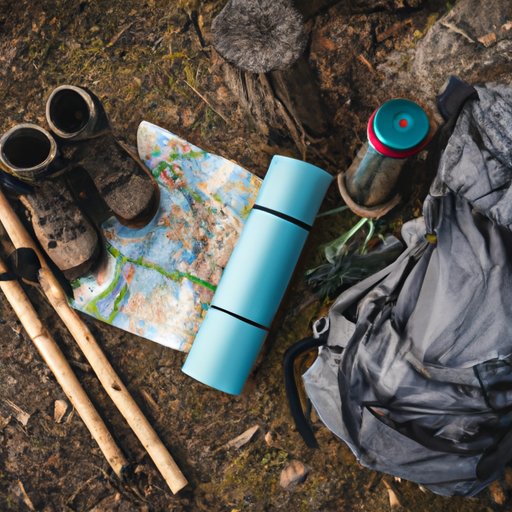Introduction
Hiking can be a fun and rewarding activity, but it requires proper preparation and equipment, including a well-packed backpack. Before you set out on your next hiking trip, it’s crucial to ensure that everything you need is neatly packed and organized in your backpack. In this article, we’ll explore essential items to include in your backpack, how to optimize space, distribute weight, plan and organize, and avoid common mistakes.
Essential Items to Include in Your Backpack for a Hiking Trip
When packing for a hiking trip, it’s essential to bring essential items that will keep you safe, hydrated, and comfortable on the trail. Here are some of the most important items:
Water and hydration system
Staying hydrated is crucial when hiking, and you should bring enough water for the entire trip. If you’re going on longer hikes, consider a hydration bladder or water bottles to make it easier to drink on the go.
Navigation tools (map and compass)
Even if you’re familiar with the trail, it’s still essential to bring a map and compass to help you navigate in case of unexpected changes. Make sure you know how to use them before heading out.
Sunscreen and insect repellent
Protect your skin from the sun’s harmful rays and keep biting insects at bay by packing sunscreen and insect repellent.
First-aid kit
If accidents happen on the trail, a first-aid kit can be a lifesaver. Your kit should include essentials like bandages, gauze, antiseptic, and medications.
Food and snacks
Keep your energy levels up on the trail by packing high-energy snacks like trail mix, energy bars, and dried fruit. Don’t forget to pack enough food for the entire trip, and consider meal planning if you’re planning an extended trip.
Clothing appropriate for the hike and weather conditions
Checking the weather forecast is crucial when packing for a hike. You should dress appropriately for the conditions, and pack extra layers in case of unexpected drops in temperature or rain. Wear comfortable and supportive shoes or boots that won’t cause blisters.
Emergency shelter (tent or bivy sack)
Unforeseen circumstances like getting lost or changing weather conditions may require you to spend an unplanned night outdoors. A tent or bivy sack can provide emergency shelter in these situations.
Headlamp or flashlight
If you plan on hiking or camping overnight, you’ll need a reliable source of light. Pack a headlamp or flashlight and extra batteries to ensure you’re never in the dark.
Multitool or knife
A multitool or knife is a versatile tool that can help you cut rope, prepare food, and make emergency repairs.
How to Optimize the Space in Your Backpack for a Comfortable Hike
The key to packing a comfortable backpack for a hiking trip is to optimize space and keep everything organized. Here are some tips:
Choosing the right backpack size
Before packing, make sure you have the right sized backpack for your trip. A backpack that’s too big or too small can be uncomfortable and throw off your balance on the trail.
Grouping items by purpose and importance
Grouping items by purpose and importance will make it easier to find what you need on the trail. For example, pack all your cooking utensils in one bag and your first-aid items in another.
Using packing cubes or stuff sacks
Packing cubes or stuff sacks can help keep your items organized and easy to find. They can also compress clothing and save space in your backpack.
Packing heavy items close to your back and lighter items towards the top
Pack your heaviest items, like your water bladder or food, close to your back. This will help keep your center of gravity lower and ensure the weight is evenly distributed. Lighter items, like your extra layers and sleeping pad, should be packed towards the top of the backpack.
Attaching bulky items to the outside of the backpack
If you have bulky items like a tent or sleeping bag, consider attaching them to the outside of your backpack. This will free up more space inside your pack for other items and help balance the weight.
How to Distribute Weight in Your Backpack for Better Balance During the Hike
Distributing weight evenly in your backpack is crucial for better balance and stability on the trail. Here are some tips:
Distributing weight evenly between both shoulders
Make sure the weight in your backpack is distributed evenly between both shoulders. An uneven load can cause discomfort and even lead to injuries.
Keeping the heaviest items centered and close to your back
Your heaviest items, like water, should be packed close to your back. This will help keep your center of gravity low and prevent discomfort or injuries.
Adjusting the backpack straps for the perfect fit
Your backpack straps should be adjusted to fit your body perfectly. A poorly fitting backpack can lead to discomfort, chafing, and even injuries. Make sure the hip belt, shoulder straps, and sternum strap are all adjusted correctly.
The Importance of Planning and Organizing Before Packing Your Backpack for a Hike
Proper planning and organizing before packing your backpack is crucial for a successful and stress-free hike. Here are some tips:
Researching the trail and weather conditions
Researching the trail and weather conditions can help you pack appropriately and ensure you have the right equipment and clothing for the trip. Check the weather forecast, trail conditions, and know the length of the hike.
Making a checklist of essential items
Before packing, make a checklist of essential items. Refer to this checklist while packing to ensure you didn’t forget anything important.
Packing extra supplies in case of emergency
Unforeseen circumstances can happen on the trail, so it’s essential to pack extra supplies in case of emergency. This might include extra food, water, and first-aid items.
Informing someone of your hiking itinerary
Before leaving for your hike, inform a family member or friend of your hiking itinerary, including your planned route, estimated time of arrival, and expected time of return. This will increase your safety and help ensure that someone knows where you are in case something goes wrong.

Tips for Packing Your Backpack for an Overnight Hiking Trip
Packing for an overnight hiking trip requires additional considerations to ensure you’re comfortable and safe. Here are some tips:
Packing a tent, sleeping bag, and sleeping pad
If you’re camping overnight, you’ll need a tent, sleeping bag, and sleeping pad. Pack these items first and on the bottom of your backpack. Make sure the tent poles are packed horizontally to prevent damage.
Bringing portable stove and cooking utensils
For cooking, pack a portable stove and cooking utensils like a pot, spatula, and bowl. Don’t forget to pack fuel for the stove.
Packing extra clothes and layers
Overnight trips can bring changes in temperature, so pack extra clothes and layers to stay warm. You should also pack clean clothes to change into after hiking all day.
How to Pack Your Backpack for a Winter Hiking Trip
Winter hiking trips require additional gear to keep you warm and safe. Here are some tips:
Packing extra warm clothing
You’ll need extra warm clothing for winter hiking trips, including a warm jacket, hat, gloves, and base layers. Wool and synthetic materials are the best to keep you warm and dry.
Bringing traction devices for icy trails
If the trail is icy or snowy, you’ll need traction devices like crampons or microspikes to prevent slipping and falling.
Considering the additional weight of winter gear
Winter gear is heavier than summer gear, so consider the additional weight when packing. You may need a larger backpack to accommodate all the extra gear.
Mistakes to Avoid When Packing Your Backpack for a Hike
When packing for a hike, there are several common mistakes to avoid:
Overpacking unnecessary items
Only pack necessary items for your hike. Overpacking can compromise your comfort on the trail and make it harder to carry your backpack.
Neglecting to check the weather forecast
Not checking the weather forecast is a common mistake that can have serious consequences. Be prepared for unexpected weather changes by packing appropriate clothing and equipment.
Not considering the weight and size of each item
When packing for a hike, consider the weight and size of each item. Heavy items should be packed close to your back, and lighter items should be packed towards the top. A backpack that’s too heavy can be uncomfortable and cause injuries.
Forgetting to test and adjust the backpack fit before the hike
Before leaving for your hike, test and adjust your backpack’s fit. It should be snug but not too tight, and the weight should be evenly distributed over both shoulders.
Conclusion
Properly packing your backpack is essential for a comfortable and safe hiking trip. Follow these tips to ensure you’re adequately prepared for your next adventure.
(Note: Is this article not meeting your expectations? Do you have knowledge or insights to share? Unlock new opportunities and expand your reach by joining our authors team. Click Registration to join us and share your expertise with our readers.)
